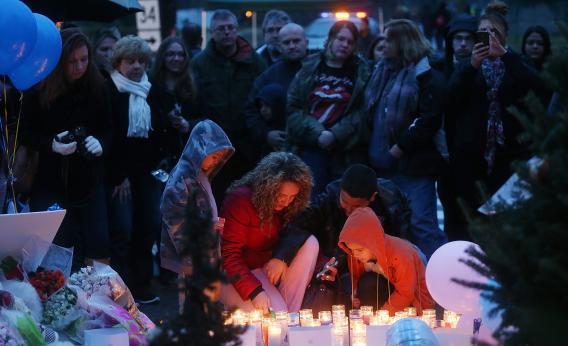Read the rest of Slate’s coverage of the Sandy Hook school shooting.
In 1985, when I was 13 years old, a woman suffering from schizophrenia brought a semiautomatic rifle to our local mall and began shooting. This was the mall where I picked out clothes from the Gap, where I sat for photos with Santa Claus as a toddler, where kids my age were just starting to hang out and flaunt their independence. The woman, 25-year-old Sylvia Seegrist, killed three people, including a 2-year-old child, and shot several others before being subdued by a man who thought she was shooting blanks. When asked why she had done it, Seegrist said, bizarrely, that “my family makes me nervous.” In other words, there was no reason at all.
As a middle-schooler, I registered the event only in the haziest terms: I knew something terrible had happened, I was glad it hadn’t happened to me, and I figured the adults would take care of the rest. Now, as an adult, what seems shocking is just how little was done. There were calls for keeping guns out of the hands of the mentally ill, for better treatment and commitment laws, for more restrictive gun control, for greater community vigilance to identify people prone to violence. But none of it, apparently, mattered quite enough. Fourteen years after the Springfield Mall shooting came Columbine, then Virginia Tech, and now Sandy Hook Elementary.
Like millions of other heartsick people, I am inclined to despair at this list, to think that though all of this must change, it never will. But as a historian I am reminded that change often comes slowly, and with great pain and effort. A century ago, there were forms of graphic, brutal violence considered so thoroughly American that they could never be banished from the national landscape. Today they no longer exist. In the story of how these changes happened, there may be a model—or a least a bit of hope—for the present.
One example is class violence, once seen a shameful but ineradicable feature of American life. Beginning in the 1870s, the United States became infamous around the world for the brutality of its labor clashes, in which gun battles, dynamitings, and hand-to-hand combat produced what seemed to be an unending stream of senseless death. Sometimes the violence came at the hands of police: 100 strikers killed during the rail uprising of 1877, 11 children burned to death in the 1914 Ludlow Massacre. On other occasions, it came as retaliation from below. In 1910, men employed by the Bridge and Structural Iron Workers blew up the headquarters of the anti-union Los Angeles Times, killing 21 printers and laborers working inside.
Compared to today’s gun massacres, it is easy to see these earlier events as a more comprehensible form of violence, with obvious political motives and straightforward political solutions. Yet Americans at the time experienced them as a cause for national soul-searching, as well as a kind of helplessness and even despair. Muckraker Lincoln Steffens put it best, after the L.A. Times bombing. “What are we Americans going to do about conditions which are bringing up healthy, good-tempered boys … to really believe … that the only resource they have … is to use dynamite against property and life?”
The arguments that followed were fierce: Should the country enact new labor laws? Engender Christian renewal? Regulate guns and explosives? But the answers were obvious even then. Americans needed a better process, enforced by the federal government, for managing labor-employer relations. Until the 1930s, advocates simply lacked the political will and public support to make it happen.
An even more intractable debate accompanied the rise and fall of lynching, one of the most gruesome forms of violence ever to take root in the United States. Today, we tend to remember lynching as a clandestine crime, a young black man pulled from his bed in the dark of night and brutalized or hanged in the Southern woods. For most of the late 19th and early 20th centuries, though, it was a community phenomenon of almost unthinkable cruelty, in which hundreds if not thousands of people gathered to witness a victim being disemboweled, castrated, tortured, or burned, then killed in full view.
To modern sensibilities, the injustice once again seems obvious, as do the solutions: Prosecute lynchers, fight for racial justice, strengthen the rule of law, and mobilize public opinion to condemn rather than excuse outbursts of brutality. And yet it took more than 100 years for lynching to begin to disappear as a feature of American life, and even longer for Americans to fully acknowledge the depth of its horror. In the meantime, thousands of influential people, including many esteemed congressmen and senators, argued that lynching was simply a fact of life, a random act of violence about which nothing could be done. It was not until 2005 that the U.S. Senate, spearheaded by Mary Landrieu, apologized for failing to pass federal anti-lynching legislation, and for leaving hundreds of innocent people to be sacrificed to official inaction.
The parallels between past and present are not perfect, of course. Today’s violence is more random, without rational motive or political purpose. Yet these examples tell us something important about how social change happens around violence, and about what we now need to do. Ending both lynching and class violence required efforts spread over many decades. And those efforts attacked the problem at multiple levels, from the passage of new federal laws to campaigns aimed at mobilizing public opinion.
Most of all, they required a mass rejection of the argument that this is just what America is like, and that there is nothing to be done. We’ve now lived with gun massacres for two generations. That’s long enough.
